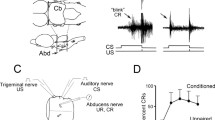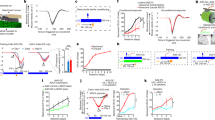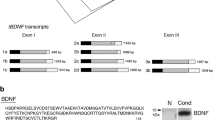Abstract
Plasticity and learning genes require regulatory mechanisms that have the flexibility to respond to a variety of sensory stimuli to generate adaptive behavioral responses. The immediate early gene (IEG) activity–regulated cytoskeleton-associated protein (ARC) is rapidly induced not only by neuronal stimulation but also during a variety of learning tasks. How ARC is regulated in response to complex stimuli during associative learning remains to be fully detailed. Here, we characterized the structure of the ARC gene in the pond turtle and mechanisms of its transcriptional activation during a neural correlate of eyeblink classical conditioning. The tARC gene is regulated in part by the presence of paused polymerase (RNAPII) that is poised at the promoter for rapid gene induction. Conditioning induces permissive chromatin modifications in the tARC promoter that allows binding by the transcription factor cAMP response element–binding protein (CREB) within 5 min of training. During learning acquisition, the pausing factor negative elongation factor (NELF) dissociates from the promoter thereby releasing RNAPII for active transcription. Data additionally suggest that the DNA insulator protein CCCTC–binding factor (CTCF) is required for transcription by mediating a learning-induced interaction of the ARC promoter with an enhancer element. Our study suggests that the learning-inducible IEG tARC utilizes both paused RNAPII and rapid chromatin modifications that allow for dynamic gene responsiveness required when an organism is presented with a variety of environmental stimuli.





Similar content being viewed by others
References
Adelman K, Lis JT (2012) Promoter-proximal pausing of RNA polymerase II: emerging roles in metazoans. Nat Rev Genet 13:720–731
Ali T, Renawitz R, Bartkuhn M (2016) Insulators and domains of gene expression. Curr Opin Gent Dev 37:17–26
Ambigapathy G, Zheng Z, Keifer J (2015) Regulation of BDNF chromatin status and promoter accessibility in a neural correlate of associative learning. Epigenetics 10:981–993
Bramham CR, Alme MN, Bittins M, Kuipers SD, Nair RR, Pai B, Panja D, Schubert M, Soule J, Tiron A, Wibrand K (2010) The arc of synaptic memory. Exp Brain Res 200:125–140
Calo E, Wysocka J (2013) Modification of enhancer chromatin: what, how, and why. Mol Cell 49:825–837
Chen H, Levo M, Barinov L, Fujioka M, Jaynes JB, Gregor T (2018) Dynamic interplay between enhancer-promoter topology and gene activity. Nat Genet 50:1296–1303
Ding X, Liu S, Tian M, Zhang W, Zhu T, Li D, Wu J, Dong H, Jia Y, Xie W, Xie H, Guan J-S (2017) Activity-induced histone modifications govern neurexin-1 mRNA splicing and memory preservation. Nat Neurosci 20:690–699
Fukuchi M, Nakashima F, Tabuchi A, Shimotori M, Tatsumi S, Okuno H, Bito H, Tsuda M (2015) Class I histone-deacetylase-mediated repression of the proximal promoter of the activity-regulated cytoskeleton-associated protein gene regulates its response to brain-derived neurotrophic factor. J Biol Chem 290:6825–6836
Galvao-Ferreira P, Lipinski M, Santos F, Barco A, Costa RM (2017) Skill learning modulates RNA pol II poising at immediate early genes in the adult striatum. eNeuro 4:e0074–e0017
Gilchrist DA, Santos GD, Fargo DC, Xie B, Gao Y, Li L, Adelman K (2010) Pausing of RNA polymerase II disrupts DNA-specified nucleosome organization to enable precise gene regulation. Cell 143:540–551
Guenther MG, Levine SS, Boyer LA, Jaenisch R, Young RA (2007) A chromatin landmark and transcription initiation at most promoters in human cells. Cell 130:77–88
Guzowski JF, McNaughton BL, Barnes CA, Worley PF (1999) Environment-specific expression of the immediate-early gene Arc in hippocampal neuronal ensembles. Nat Neurosci 2:1120–1124
Guzowski JF, Setlow B, Wagner EK, McGaugh JL (2001) Experience-dependent gene expression in the rat hippocampus after spatial learning: a comparison of the immediate-early genes Arc, c-fos, and zif268. J Neurosci 21:5089–5098
Heintzman ND, Hon GC, Hawkins RD, Kheradpour P, Stark A, Harp LF, Ye Z, Lee LK, Stuart RK, Ching CW, Ching KA, Antosiewicz-Bourget JE, Liu H, Zhang X, Green RD, Lobanenkov VV, Stewart R, Thomson JA, Crawford GE, Kellis M, Ren B (2009) Histone modifications at human enhancers reflect global cell-type-specific gene expression. Nature 459:108–112
Ichikawa H, Fujimoto T, Taira E, Miki N (2003) The accumulation of Arc (an immediate early gene) mRNA by the inhibition of protein synthesis. J Pharmacol Sci 91:247–254
Kawashima T, Okuno H, Nonaka M, Adachi-Morishima A, Kyo N, Pkamura M, Takemoto-Kimura S, Worley PF, Bito H (2009) Synaptic activity-responsive element in the Arc/Arg3.1 promoter essential for synapse-to-nucleus signaling in activated neurons. Proc Natl Acad Sci 106:316–321
Keifer J (2017) Primetime for learning genes. Genes 8:1–12
Keifer J, Zheng Z (2017) Cold block of in vitro eyeblink reflexes: evidence supporting the use of hypothermia as an anesthetic in pond turtles. J Exp Biol 220:4370–4373
Keifer J, Armstrong KE, Houk JC (1995) In vitro classical conditioning of abducens nerve discharge in turtles. J Neurosci 15:5036–5048
Keifer J, Zheng Z, Mokin M (2008) Synaptic localization of GluA4-containing AMPARs and Arc during acquisition, extinction, and reacquisition of in vitro classical conditioning. Neurobiol Learn Mem 90:301–308
Kim T-K, Hemberg M, Gray JM, Costa AM, Bear DM, Wu J, Harmin DA, Laptewicz M, Barbara-Haley K, Kuersten S, Markenscoff-Papadimitriou E, Kuhl D, Bito H, Worley PF, Kreiman G, Greenberg ME (2010) Widespread transcription at neuronal activity-regulated enhancers. Nature 465:182–187
Korb E, Finkbeiner S (2011) Arc in synaptic plasticity: from gene to behavior. TINS 34:591–598
Li L, Carter J, Gao X, Whitehead J, Tourellotte WG (2005) The neuroplasticity-associated Arc gene is a direct transcriptional target of early growth response (Egr) transcription factors. Mol Cell Biol 25:10286–10300
Liu J, Wu X, Zhang H, Pfeifer GP, Lu Q (2017) Dynamics of RNA polymerase II pausing and bivalent histone H3 methylation during neuronal differentiation in brain development. Cell Rep 20:1307–1318
Lyons MR, West AE (2011) Mechanisms of specificity in neuronal activity-regulated gene transcription. Prog Neurobiol 94:259–295
Malik AN, Vierbuchen T, Hemberg M, Rubin AA, Ling E, Couch CH, Stroud H, Spiegel I, Farh KK-H, Harmin DA, Greenberg ME (2014) Genome-wide identification and characterization of functional neuronal activity-dependent enhancers. Nat Neurosci 17:1330–1339
Matsumura Y, Nakaki R, Inagaki T, Yoshida A, Kano Y, Kimura H, Tanaka T, Tsutsumi S, Nakao M, Doi T, Fulami K, Osborne TF, Kodama T, Aburatani H, Sakai J (2015) H3K4/H3K9me3 bivalent chromatin domains targeted by lineage-specific DNA methylation pauses adipocyte differentiation. Mol Cell 60:584–596
Min IM, Waterfall JJ, Core LJ, Munroe RJ, Schimenti J, Lis JT (2011) Regulating RNA polymerase pausing and transcription elongation in embryonic stem cells. Genes Dev 25:742–754
Mokin M, Lindahl JS, Keifer J (2006) Immediate-early gene-encoded protein Arc is associated with synaptic delivery of GluR4-containing AMPA receptors during in vitro classical conditioning. J Neurophysiol 95:215–224
Mukhopadhyay A, Deplancke B, Walhout AJ, Tissenbaum HA (2008) Chromatin immunoprecipitation (ChIP) coupled to detection by quantitative real-time PCR to study transcription factor binding to DNA in Caenorhabditis elegans. Nat Protoc 3:698–709
Pintchovski SA, Peebles CL, Kim HJ, Verdin E, Finkbeiner S (2009) The serum response factor and a putative novel transcription factor regulate expression of the immediate-early gene Arc/Arg3.1 in neurons. J Neurosci 29:1537–1525
Saha RN, Wissink EM, Bailey ER, Zhao M, Fargo DC, Hwang J-Y, Daigle KR, Fenn JD, Adelman K, Dudek SM (2011) Rapid activity-induced transcription of Arc and other IEGs relies on poised RNA polymerase II. Nat Neurosci 14:848–856
Sams DS, Nardone S, Getselter D, Raz D, Tal M, Rayi PR, Kaphzan H, Hakim O, Elliot E (2016) Neuronal CTCF is necessary for basal and experience-dependent gene regulation, memory formation, and genomic structure of BDNF and Arc. Cell Rep 17:2418–2430
Steward O, Worley PF (2001) Selective targeting of newly synthesized Arc mRNA to active synapses requires NMDA receptor activation. Neuron 30:227–240
Su Y, Shin J, Zhong C, Wang S, Roychowdhury P, Lim J, Kim D, Ming G, Song H (2017) Neuronal activity modifies the chromatin accessibility landscape in the adult brain. Nat Neurosci 20:476–483
Voigt P, Tee W-W, Reinberg D (2013) A double take on bivalent promoters. Genes Dev 27:1318–1338
Waltereit R, Dammermann B, Wulff P, Scafidi J, Staubli U, Kauselmann G, Bundman M, Kuhl D (2001) Arg3.1/Arc mRNA induction by Ca2+ and cAMP requires protein kinase A and mitogen-activated protein kinase/extracellular regulated kinase activation. J Neurosci 21:5484–5493
Zheng Z, Sabirzhanov B, Keifer J (2012) Two-stage AMPA receptor trafficking in classical conditioning and selective role for glutamate receptor subunit 4 (tGluA4) flop splice variant. J Neurophysiol 108:101–111
Zheng Z, Ambigapathy G, Keifer J (2017) MeCP2 regulates Tet1-catalyzed demethylation, CTCF binding, and learning-dependent alternative splicing of the BDNF gene in turtle. eLife 6:e25384
Funding
J.K was supported by institutional departmental funds.
Author information
Authors and Affiliations
Corresponding author
Ethics declarations
All experiments involving the use of animals were performed in accordance with the guidelines National Institutes of Health and were approved by the University of South Dakota Institutional Animal Care and Use Committee.
Conflict of Interest
The authors declare that they have no conflicts of interest.
Additional information
Publisher’s Note
Springer Nature remains neutral with regard to jurisdictional claims in published maps and institutional affiliations.
Electronic supplementary material
Supplemental Fig. 1
The cDNA sequence of the 5′ flanking region and exons I-III of tARC for T. scripta elegans (GenBank: MG851989.1). Asterisks mark the transcription start sites. The protein coding sequence is shown in italics. The start and stop codons are indicated as are some of the notable transcription factor binding sites and polyadenylation sites. Primers for RLM-RACE are also shown. (PNG 3180 kb)
ESM 1
(PNG 311 kb)
Rights and permissions
About this article
Cite this article
Zheng, Z., Ambigapathy, G. & Keifer, J. Characterization and Transcriptional Activation of the Immediate Early Gene ARC During a Neural Correlate of Classical Conditioning. J Mol Neurosci 69, 380–390 (2019). https://doi.org/10.1007/s12031-019-01367-z
Received:
Accepted:
Published:
Issue Date:
DOI: https://doi.org/10.1007/s12031-019-01367-z




